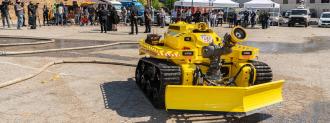Fighting fires is — as you might guess — dangerous work.
Firefighters must get close enough to a blaze to blast it with water or foam. Sometimes, that means entering a burning structure that could collapse at any moment. Other times, it means getting dangerously close to explosive materials, like the gas tank of a flaming vehicle.
For firefighters in Los Angeles, though, the job just got safer thanks to their newest coworker: a firefighting robot.
LAFD’s Firefighting Robot
The firefighting robot is called the Thermite RS3, and it looks like a military tank that someone shrunk down and painted bright yellow.
It’s controlled via a wireless remote and equipped with several cameras (including an infrared one) that let firefighters see what the bot sees.
The 3,500-pound machine isn’t fast (top speed is just 8 miles per hour), but it is powerful. Using its front plow blade, the firefighting robot can knock down the wall of a building or even push a car.
Both of those skills could help firefighters in the line of duty, but the machine’s most useful feature is its water cannon — once connected to a fire hose, this cannon can expel 2,500 gallons of water or foam per minute.
“You can turn the water cannon vertical and turn it into its own sprinkler system,” Los Angeles Fire Department (LAFD) Chief Ralph Terrazas told the Los Angeles Times. “It may make us rethink some of the ways we tackle fires when it’s available.”
First Day on the Job
The firefighting robot cost about a quarter of a million dollars, but the money didn’t come out of the LAFD’s budget — the LAFD Foundation, a nonprofit founded to support the department, raised the funds.
The LAFD is the first department in the U.S. to own an RS3, and it wasted no time in putting its new tool to use.
I can afford to lose one of these machines. I cannot afford to lose a firefighter.
Ralph Terrazas
The plan was to debut the RS3 during a press conference on the afternoon of October 13, but that morning, the department got a call about a structure fire in downtown LA and decided to take their new robot coworker along to help them battle it.
It took more than 130 firefighters to quell the massive blaze. At one point, the building was at risk of collapsing so the department pulled its people out and sent its firefighting robot in.
“I can afford to lose one of these wonderful machines,” Terrazas said. “I cannot afford to lose a firefighter.”
We’d love to hear from you! If you have a comment about this article or if you have a tip for a future Freethink story, please email us at [email protected].





